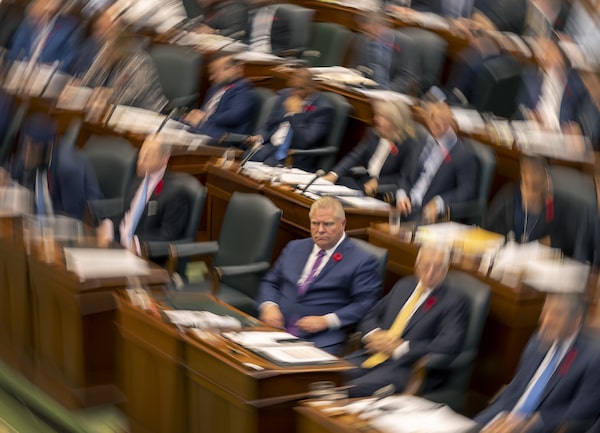
Ontario Premier Doug Ford sits in the Ontario Legislature during Question Period on Nov. 1, as members debate a bill meant to avert a planned strike by 55,000 education workers.Frank Gunn/The Canadian Press
Patrick Groom is a partner at McMillan LLP and designated as a certified specialist in labour law by the Law Society of Ontario.
In his efforts to keep kids in the classroom this fall, Ontario Premier Doug Ford has generated unprecedented uproar by invoking the notwithstanding clause to limit rights under the Charter of Rights and Freedoms for the first time in a labour dispute – but it may have been the only tool he had to keep schools open.
The alternative would be making costly concessions to the Canadian Union of Public Employees (CUPE), whose strike notice prompted the move. CUPE’s original demands include wage increases of 11.7 per cent a year for three years, an increase not seen anywhere else in our economy, which would create unrealistic precedents for upcoming negotiations with the various teachers’ unions.
Since 1982, when the Charter was enacted, there have been more than 94 instances where a federal or provincial government has used back-to-work legislation to end a labour dispute. In that 40-year period, Ontario alone used such legislation approximately 25 times to end strikes and control spiralling labour costs, which are one the most expensive line items in every government budget. Notable examples in Ontario include college and university teacher strikes, public-transit job actions, municipal and garbage workers’ strikes, and construction strikes. The federal government has used such legislation to restore mail service after job action in 2011 and assist Air Canada in resuming operations when workers walked out in 2012.
But in the decades since the Charter took effect, the Supreme Court of Canada has also issued a series of decisions that have defined that labour rights are, in fact, protected. The result is that back-to-work legislation that limits collective bargaining and prevents strikes – an important legislative tool of last resort for decades – is no longer available to get people back to work and protect our economy.
Precedent was set with a series of decisions issued in 1987 referred to as the “First Labour Trilogy.” These decisions held that section 2(d) of the Charter protects only individual rights and does not create rights to strike or collectively bargain. But over the following decades, the Supreme Court issued decisions that incrementally expanded Charter protections for collective bargaining, culminating in the “Second Labour Trilogy” in 2015. In those three decisions, the Supreme Court gave collective bargaining and the ability to strike Charter protections that never existed so explicitly before; a complete reversal from the legal framework established in 1987, which had clearly set out the interpretation, application and limitation of Charter protections originally intended for labour relations.
The practical effects of the “Second Labour Trilogy” decisions came to light in 2016, when the Superior Court of Justice found that Ontario had infringed on the rights of several education unions. In 2012, the Liberal government of the day passed Bill 115, the Putting Students First Act, to impose certain collective-agreement terms that had been negotiated with the Ontario English Catholic Teachers’ Association (OECTA) on the five other education unions, including CUPE. Bill 115 left certain terms to be negotiated individually with each of the five other unions, but such negotiations were quite limited. More importantly, Bill 115 pre-emptively blocked the five unions’ ability to strike.
In enforcing the newly established rights to strike and collectively bargain from the Second Labour Trilogy, the Superior Court held that the Liberal government owed an undetermined amount of damages to the five affected unions for violating these rights. The final bill to the Ontario government amounted to over $212-million, with the last settlement of $103.1-million payable to the Elementary Teachers Federation of Ontario finalized in February, 2022.
Thanks to the Second Labour Trilogy and the Superior Court’s 2016 damages award, organized labour’s successful expansion of constitutional protections of union activities leaves governments with only one route to avoid liability when imposing back-to-work legislation: the notwithstanding clause in section 33 of the Charter.
By invoking the notwithstanding clause for Bill 28, the Keeping Students in Class Act, the freedom of association in section 2(d) of the Charter will not apply to Bill 28 for five years, which is the maximum term that the notwithstanding clause can apply unless renewed. In essence, this is a return to the legal framework established by the Supreme Court shortly after the Charter was enacted. Since Bill 28 imposes collective-agreement terms for only a four-year period, CUPE is, and other education unions would likely be, deprived of the ability to rely on the Charter to strike, shut down schools, and seek hundreds of millions more in damages.
Some academics and politicians have called on the Ford government to modify Bill 28, remove reference to the notwithstanding clause, and defend its legislation in court by arguing that infringing on the rights to collectively bargain and strike are justified. But why? The notwithstanding clause is a practical and complete solution available to any government that deems such back-to-work legislation necessary. Whether such legislation is necessary is a political issue, not a legal one, so such litigation of Bill 28 will only satisfy academics and enrich lawyers at the expense of the public purse and stressed parents who worry whether school will be open or closed at CUPE’s whim.
While this might be the first time the notwithstanding clause is used to end a labour dispute and prevent strike action, it may not be the last. This may be a path forward for governments to again use back-to-work legislation when labour disputes pose a major threat to our children’s welfare, our economy and growth without incurring millions of dollars in costs and damages.